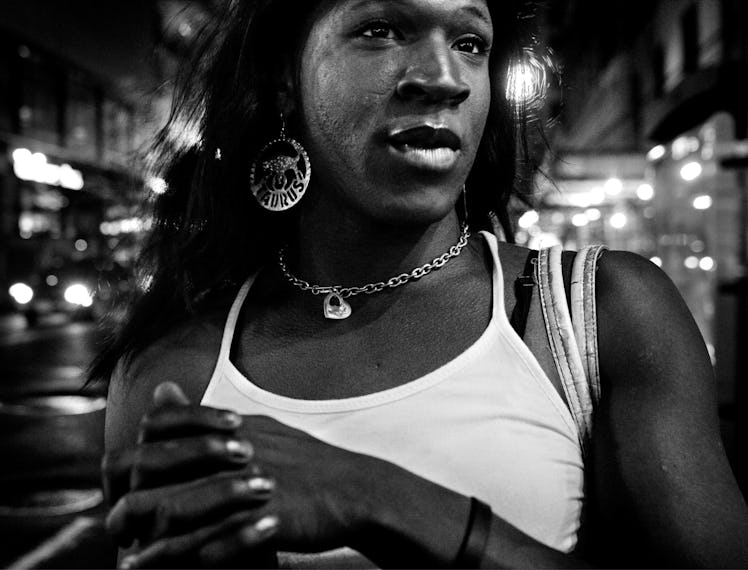Before Sex and the City, There Was The Stroll
In her deeply personal documentary, filmmaker Kristen Lovell traces the importance of NYC’s Meatpacking District for the trans community.

One night in 1999, Kristin Lovell decided to hit the block early. At the time she was a sex worker and New York City’s Meatpacking District—particularly the strip of 14th Street running from 8th Avenue to the river—was her turf. It was the turf of many trans women, actually, who shared it with literal meat packers.
“It was like 10 or 11 [at night] and I saw a woman in a gold jacket in one of those director’s chairs on the street,” Lovell recalls to W. Filming in the area wasn’t uncommon, so she stuck around to watch. “Then I realized it was Kim Cattrall, and I remembered her from Mannequin.” The action Lovell was playing witness to was the now infamous scene from Sex and the City, where Samantha finds her sleep—and her orgasms—interrupted by a group of working girls. Watching this outsider’s take on her life repulsed Lovell. But in the wake of the show airing, as fans flocked to the area and its environs, patronizing Pastis and Magnolia Bakery for their slice of the “Sex and the City experience,” she watched the dynamic play out again on a larger, more permanent scale as sex workers were forced to vacate the neighborhood.
“It’s like that phrase, life imitates art,” Lovell says. “[In the show,] she throws the water on the girls and the police come and push them out of the area. That’s what happened in real life. I knew the area was changing when I saw the first Christian Louboutin store.”
In The Stroll, an HBO documentary that premiered on MAX this summer, Lovell tells the story of that change. She sketches an arc for the Meatpacking District from being a popular haunt for trans sex workers in Manhattan, up through the glossy Madison Avenue-like tourist attraction it is today. Grounded in her own personal story, the documentary shows how the ousting of Lovell’s community was not a result of passive gentrification, but the product of a concerted, unrelenting, and at times terroristic effort.
“I still have flashbacks,” she says. “I stayed away from the area for a number of years. When I started to go back I would be scared, as if, ‘Oh my God, if I step foot here will I get arrested just for being a trans woman because they’ve made it into all of this?’”
It is unknown exactly how long Manhattan’s Meatpacking stroll has been in existence—specific streets and districts that have gained a reputation for sex work and have become known as “strolls” exist across the U.S.—but Lovell’s research has turned up images and newspaper articles referencing it from as early as the 1960s. For a time, working the area was one of the only ways trans women could make money as a result of rampant discrimination.
A trans sex worker on the stroll (1980s)
As the film finds, the women there formed their own community of sorts. They sometimes showed each other the ropes and at other points functioned as their own protectors in the face of prejudice and apathy by police and local public services. In 1992, the area became the subject of a segment on Manhattan Neighborhood Network, a local public access TV station.
“Located in Manhattan’s Lower West Side, the meat market is filled with transvestite hookers by night,” drag superstar RuPaul Charles says in the footage, parts of which were included in the documentary. “I ought to know because I live right around the block.”
Charles skitters across the cobblestones in sky-high heels, shoving a microphone into the faces of the working girls, often making light of their situation. While Lovell was “enamored” by the vivid footage, on-screen she chastises Charles’ condescending approach. With clips of the huge empty meat trucks and graffitied load-in docks, it’s these same spaces that The Stroll revisits 30 years later.
Only now, it’s all changed. Sex and the City debuted in 1998, while the “Cock-a-Doodle-Do” episode Lovell played witness to aired in late 2000. At the time, under Mayor Rudy Giuliani, police had adopted a bit of a catch-and-release strategy for sex workers.
“Under Giuliani, we would get community service when we were arrested,” Lovell says. “We would have to do a workshop or stamp envelopes, but that was about it. But when Bloomberg came in there was this uptick of policing. That’s where you saw the vice squads and detectives. It felt like an invasion, and they were literally abducting us off the streets.”
The brandishing of policies like the Walking While Trans bill saw girls being sent upstate for longer periods of time. And much like Samantha in Sex and The City, neighborhood associations began to organize their own efforts, taking down the license plates of clients in the area and alerting their jobs and families. The invasion wiped the streets clean for the lacquered neighborhood we know today of glitzy shops and chic restaurants.
“The culture of New York City is lost,” Lovell says of the impact. “What made it so fun back in the day was you could come outside and there were people and parties and all this stuff going on. Now there’s no community, it’s all just tourists.”
“It’s a shell of itself,” she continues. “Just dry and empty.”
The Stroll is now streaming on MAX.
This article was originally published on